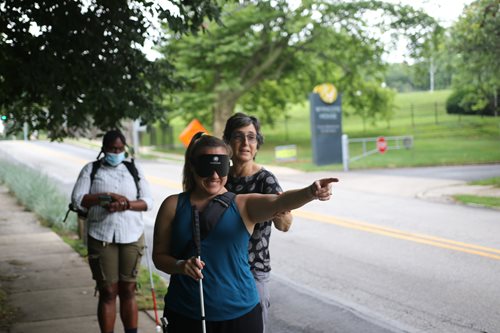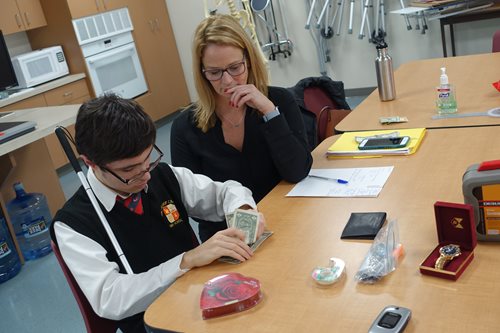The University’s programs in Blindness and Low Vision Studies (BLVS) were first developed in 1983, making the then Pennsylvania College of Optometry - now Salus - the first institution in the country to offer four master’s degrees and certificates in blindness and low vision disciplines.
 As the Orientation and Mobility (O&M) and Vision Rehabilitation Therapy (VRT) programs each celebrated their 30th anniversary this past year, it’s the perfect opportunity for the University to reflect on the department’s continued excellence, innovation, and service.
As the Orientation and Mobility (O&M) and Vision Rehabilitation Therapy (VRT) programs each celebrated their 30th anniversary this past year, it’s the perfect opportunity for the University to reflect on the department’s continued excellence, innovation, and service.
What started as small programs with only a few students have now trained students from all over the world, including 28 U.S. States, Canada, France, Puerto Rico, the U.S. Virgin Islands, Saudi Arabia, and Singapore.
One of those students - Suha Almusa, MS ’22 - came to Salus from Saudi Arabia. “There is a huge need for certified O&M professionals in my country, not only for adults but also for children who might face some challenges in walking and developmental delays because they cannot travel safely,” she said.
As a recent graduate of the program, it is believed Almusa is the only female certified O&M specialist in her home country, and as she transitions into professional practice, she is excited to share her knowledge and aims to establish an accredited O&M program in Saudi Arabia.
The program’s international reach, accreditation from the Association for Education and Rehabilitation of the Blind and Visually Impaired (AER), and high exam pass rates according to the Academy for Certification of Vision Rehabilitation & Education Professionals (ACVREP) reports, are among the programs’ most significant accomplishments in the last three decades.
These achievements reflect the O&M and VRT programs’ long-standing commitment to producing competent and prepared professionals, ready to make an impact supporting children and adults with visual impairments.
“Our programs in BLVS have sustained steady growth and increased recognition both nationally and internationally,” said Fabiana Perla, MS ‘93, EdD, COMS, CLVR, BLVS chair. “The programs prepare much-needed professionals to provide high-quality services for this traditionally underserved population. In addition, through a collaboration with the William Feinbloom Vision Rehabilitation Center and PCO, BLVS faculty and students provide rehabilitation services to patients, making comprehensive care and interprofessional practice a reality.”
The program's impact is not only recognized by the University but is heavily emphasized by outside constituents. ”As a funder supporting many organizations working in low vision and blindness, I am very aware of the high regard in which Salus graduates are held,” said Susan Olivio, executive director and chief executive officer of the Lavelle Fund for the Blind, a charitable grant-making foundation dedicated primarily to supporting programs that help individuals who are blind or visually impaired live independent and productive lives. “Salus is consistently mentioned as the standard by which other programs are measured.”
According to the Centers for Disease Control and Prevention (CDC), “more than 7 million Americans have vision impairment, including 1 million who are blind. Another 93 million U.S. adults are at risk for severe vision loss. These numbers are expected to increase because of the aging population and increase in chronic diseases.”
 That unfortunately coincides with the national shortage of BLVS professionals. It is imperative that the Salus BLVS programs continue producing competent experts in their field as their impact will be important to the future of the profession.
That unfortunately coincides with the national shortage of BLVS professionals. It is imperative that the Salus BLVS programs continue producing competent experts in their field as their impact will be important to the future of the profession.
“The clients we serve get to choose the level of independence they are most comfortable with and I get to empower them with knowledge and skills and resources to help them achieve that goal,” said Lachelle Smith, MS ‘03, CVRT, VRT program director. “I’m not just helping them, I’m helping them help themselves. That’s the enlightening, empowerment and encouragement I enjoy passing on to our students. And, then when you do that, you see them pass that information along to others - that’s the best feeling.”
Amidst the national shortage, the VRT and O&M programs have been innovators in many respects – for example, both programs started as in-person but were among the first to go virtual, long before the pandemic forced that issue for many universities. The hybrid learning format makes the program accessible to students all over the world, and has helped grow its international reach.
“We’ve always been positioned as a department looking ahead and seeing how we can respond to the ever-changing environment and landscape,” said Jamie Maffit, MS ‘06, COMS, CLVT, O&M program director.
Innovation has allowed both the programs and department to grow to become as highly respected as they are today, educating graduate students and offering a variety of interprofessional services directly to patients and those in need. It is this combination of theory and practice that allows these programs to stay current and agile, and respond to trends and needs in the profession.